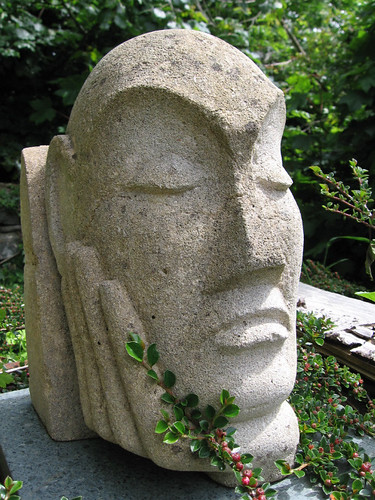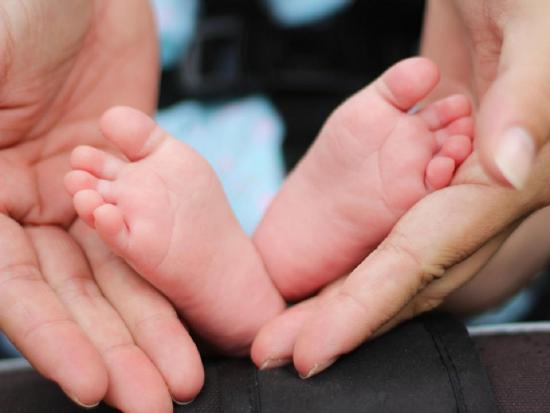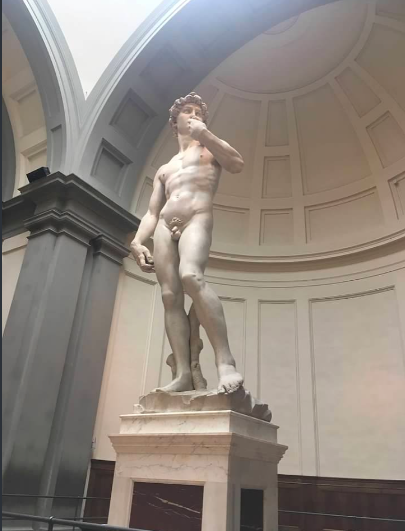2.3: I verbi e il corpo umano
- Page ID
- 147680
Leggiamo!
|
Artemisia e sua sorella Giuditta arrivano in piazza Duomo alle 9:55. Non hanno fretta e sono molto rilassate. Michelangelo e Tommaso camminano velocemente e parlano. Michelangelo: “ Tommaso, ecco, Artemisia e sua sorella sono lì. Andiamo!” Artemisia” “Ciao Michelangelo, questa è Giuditta!” Giuditta: “Piacere, mi chiamo Giuditta.” Michelangelo: “Ragazze, lui è Tommaso. “ Tommaso: “Piacere!” Michelangelo: “ Andiamo al museo del Bargello, andiamo a piedi, non è lontano” Artemisia: “Benissimo.” Mentre camminano, Michelangelo racconta la storia del museo del Bargello. Michelangelo: “ Il museo del Bargello è dedicato alla scultura. Lì ci sono opere di Michelangelo, Donatello, Ghiberti, Cellini, Giambologna, Ammannati e molti altri scultori. Il museo si chiama Bargello perché deriva dal palazzo del Bargello che significa “Palazzo del Popolo. Il palazzo è molto antico e risale al 1255.” Qui per sapere di più => Artemisia: “ Abbiamo bisogno di un biglietto?” Michelangelo: “Sì, ma ho qui i biglietti. Se avete bisogno di comprare i biglietti c’è questo sito” Artemisia: “ Quanto costano?” Michelangelo: “Solo due Euro a persona perché siamo studenti. Per Tommaso costa 20 Euro”.
|
Artemisia and her sister Giuditta arrive in Piazza Duomo at 9:55 am. They are in no hurry and are very relaxed. Michelangelo and Tommaso walk quickly and talk. Michelangelo: "Tommaso, here, Artemisia and her sister are there. Let's go!" Artemisia" "Hello Michelangelo, this is Giuditta!" Giuditta: "Nice to meet you. My name is Giuditta." Michelangelo: "Girls, this is Tommaso. " Thomas: "Pleasure to meet you!" Michelangelo: "We go to the Bargello museum, we go on foot, it’s not far away" Artemisia: "Very good." As they walk, Michelangelo tells the story of the Bargello museum. Michelangelo: "The Bargello Museum is dedicated to sculpture. There are works by Michelangelo, Donatello, Ghiberti, Cellini, Giambologna, Ammannati and many other sculptors. The museum is called Bargello because it comes from the Bargello Palace which means "Palazzo del Popolo. The palace is very old and dates back to 1255." Here to find out more => Michelangelo: "Yes, but I have tickets here. If you need to buy tickets there is this site"
Michelangelo: "Only two Euro per person because we are students. For Tommaso it costs 20 Euro". |
Il museo del Bargello: |
RISPONDI ALLE DOMANDE:
1- A che ora Artemisia e Giuditta arrivano in Piazza Duomo?
2- Come sono le due sorelle?
3- Come camminano Tommaso e Michelangelo?
4- Come vanno al Museo del Bargello?
5- Che tipo di museo è il Museo del Bargello?
6- Come comprano i biglietti?
7- Quanto costano i biglietti?
In this section, you will learn Italian verbs of first conjugation and the irregural ANDARE
How to identify parts of the human body.
Studiamo !
The regular Italian verbs are classified in three Conjugations -are, -ere, -ire (and -isc). For example : the verb amare belongs to the 1a coniugazione -are; the verb mettere belongs to 2a coniugazione -ere (and all the verbs in -rre as porre, tradurre, trarre; the verb dormire belongs to the 3a coniugazione -ire (the verb finire belongs to the 3a coniugazione -ire, type "isc").
To conjugate, coniugare comes from lat. "coniugare" to join together "stem" and "ending" , we are able to conjugate a verb when we are able to recognize its paradigm, pattern and attaching to it the correct endings, which variate from person to person, to time, and mood and to “group verbs.
Each conjugation has particular thematic vowels: a for -are; e for ere; i for ire.
|
1 coniugazione: FAMILY VERB 1 es. Lavor-ARE to work |
2 coniugazione: FAMILY VERB 2 es. Legg-ERE to read |
3 coniugazione: FAMILY VERB 3 a es. Dorm-IRE to sleep |
3 Coniugazione (tip: you have to count 5 letters from the end and if the fifth is a vowel verbs in IRE will be ISC verbs) as FAMILY VERB 3b fin-IRE to finish |
|---|---|---|---|
|
Io lavor-O I work |
Io legg-O I read |
Io dorm-O I sleep |
Io finISCO I finish |
|
Tu lavor-I you work |
Tu legg-I you read |
Tu dorm-I you sleep |
Tu finISCI you finish |
|
Lui/lei lavor-A he/she work you formal: you work |
Lui/Lei legg-E he/she reads you formal: You read |
Lui/lei dorm-E he/she sleeps you formal: You sleep |
Lui/Lei finISCE he/she finishes you formal: You finish |
|
Noi lavor-IAMO we work |
Noi legg-IAMO we read |
Noi dorm-IAMO we sleep |
Noi finIAMO we finish |
|
Voi lavor-ATE you plur work |
Voi legg-ETE you plur read |
Voi dorm-ITE you plur sleep |
Voi finITE you plur finish |
|
Loro lavor-ANO they work |
Loro legg-ONO they read |
Loro dorm-ONO they sleep |
Loro finISCONO they finish |
What is a verb? And how to coniugate verbs?
Watch https://youtu.be/IU5phP2iadw
ANDARE means to go and it is an irregular verb
|
io vado tu vai lui/lei/Lei va noi andiamo voi andate loro vanno |
I go you go he/she/ goes You formal: You go we go you plur. go they go |




Le parti del corpo
 |
 |
Knowing the parts of the body can come in handy when playing sports, clothes shopping, seeing the doctor, and more. Learn how to talk about your body in French, from head to toe.
| Italiano | Inglese |
|---|---|
| il corpo | body |
| i capelli | hair |
| la testa | head |
| il cranio | skull,head |
| il viso | face |
| l'occhio | eye |
| gli occhi | eyes |
| il naso | nose |
| la guancia | cheek |
| la bocca | mouth |
| le labbra | lips |
| i denti | teeth |
| la lingua | tongue |
| l'orecchio | ear |
| il collo | neck |
| la gola | throat |
| i polmoni (m.) | lungs |
| il petto | chest |
| il cuore | heart |
| lo stomaco | stomach |
| la pancia, il ventre | stomach |
| il braccio | arm |
| la spalla | shoulder |
| il gomito | elbow |
| il polso | wrist |
| la mano | hand |
| il dito (plur le dita) | finger |
| l'unghia | fingernail |
| il pollice | thumb |
| la schiena | back |
| il sedere o il culo | buttocks |
| la gamba | leg |
| il polpaccio | thigh |
| il ginocchio | knee |
| la caviglia | ankle |
| il piede | foot |
| il dito del piede | toe |
| Italiano | inglese |
|---|---|
| sedia a rotelle | wheelchair |
| stampella | crutch |
| bastone | cane |
| deambulatorio | walker |
| gesso | cast |
| fasciatura | sling |
| lettore del video | screen reader |
| braille | braille |
| apparecchio acustico | hearing aid |
| Italiano | Inglese |
|---|---|
| handiccapato, disabile | handicapped, disabled |
| cieco | blind |
| non vedente | vision-impaired, blind |
| sordo | deaf |
| con diffocoltà uditive | hard-of-hearing |
| amputato | amputated |
| paraplegico | paraplegic |
| cane per i non vedenti | seeing-eye dog |
| traduttore/traduttrice per la lingua dei gesti | sign language translator |
| difficoltà d'apprendimento | learning disability |
| iperattivo | hyperactivité |
| Disturbo da decit dell'attenzione | Attention Deficit Hyperactivity Disorder (ADHD) |
| Stress post-traumatico | Post Traumatic Stress Disorder (PTSD) |
Study the Quizlet vocabulary flashcards. Listen and repeat the Italian pronunciation.
In Italian, you don't usually use possessive adjectives to indicate the owner of a given body. Instead, you use a reflexive pronoun (like me below) to indicate the owner, plus a definite article. For example:
Mi lavo le mani. (I wash my hands.)
Lavo le mie mani. (I wash my hands.)
Attività con una canzone : https://docs.google.com/presentation...it?usp=sharing
Attività A
Il corpo. Identify the body parts indicated below using definite articles (e.g., la gola, le braccia, etc.)

Attività B
Il viso. Identify the parts of the face using definite articles.

"Taiwanese Face" by 540awei, Openclipart is in the Public Domain, CC0
Note
Do you know the English nursery rhyme « Head, shoulders, knees and toes »?
Here’s an Italian version:


